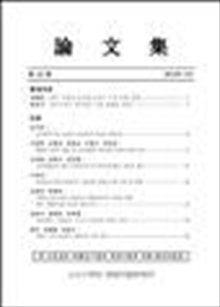간행물
大田大學校 環境問題硏究所 論文集 대전대학교 환경문제연구소 논문집 Journal of The Institute of Environmental Studies

- 발행기관 대전대학교 환경문제연구소
- 자료유형 학술지
- 간기 연간
- ISSN 2287-1527 (Print)
- 수록기간 1996 ~ 2016
- 주제분류 공학 > 환경공학 공학 분류의 다른 간행물
- 십진분류KDC 539DDC 628
권호리스트/논문검색
제20호 (2016년 2월) 6건
1.
2016.02
구독 인증기관 무료, 개인회원 유료
4,000원
2.
2016.02
구독 인증기관 무료, 개인회원 유료
This study was carried out to improve the performance of sewer trenchless entire repair method by using the multifunctional safety high-pressure hose. Because the flexural strength and flexing modulus of elasticity increased in the range from 60℃ to 80℃ of the setting temperature, the unform quality was secured to satisfy the standard quality and consolidate the strength, by supplying steam to the entire sewer through the safety high-pressure hose simultaneously. After the steam was supplied, the temperature of the condensate water with a large amount occurred , compared with a small amount, was very low. So, the setting time was shorter over than one hour by reducing the unsatisfied cure state and excluding the condensate water. The standard quality increased by approximately 15% at upper, central, and lower points of the same sewer was gained from the test result of CIPP(cured in place pipes) constructed at the optimum setting temperature. The steam and air were supplied evenly to the sewer by controlling the safety high-pressure hose in the tense and relaxed state and by using the exclusive function of condensate water. The availability and safety for the constructed process were achieved.
4,000원
3.
2016.02
구독 인증기관 무료, 개인회원 유료
The purpose of this study is to evaluate the performance of a tube and badge type NO2 passive air sampler. The principle of the method is a colorimetric reaction of NO2 with N-1-naphthylethylendiamine under acidic conditions. The sampling rates for the tube and badge type passive air samplers was determined 12.3 ± 4.4 mL/min and 27.3 ± 4.9 mL/min, respectively, as obtained from the slope of the linear correlation between the NO2 mass collected by the passive air sampler and the NO2 concentration with the NO2 analyzer. The tube and badge type passive air sampler were moderately correlated with a correlation coefficient of 0.9112. The measurement for the precision and accuracy of the passive air sampling was carried out with duplicate measurement of passive air samplers. The passive air sampler had good precision and accuracy for measuring NO2 in atmosphere. A good correlation was observed between the passive air sampler and the NO2 analyzer with a coefficient of determination of 0.9153 (tube type) and 0.9514 (badge type). This passive air sampler would be suitable for the NO2 concentration monitoring in atmosphere.
4,000원
4.
2016.02
구독 인증기관 무료, 개인회원 유료
This study was carried out to recommend the recycling technology from the organic wastes generated in the neighborhood of a dam in Kroea. The order of production of the organic wastes without the suspended materials and energy corps are Chungju-dam(649.9 ton/day), Daechung-dam(525.1ton/day), Hapcheon-dam(485ton/day), Namgang-dam(478ton/day), and Soyang-dam(246.4ton/day). Because livestock excretions and nightsoil were composed of 72 to 93% of the total organic wastes, they should be proferly reflected in the plan of recycling. It was investigated that the biodegradability was 40~80%, biogas production, 0.22~1.70m3/kg VS, methan production, 0.15~1.07m3/kg VS, and methan contents, 63~79%, respectively, in case of the livestock excretions, which constituted over than 50% of organic wastes. Therefore, the appropriate technology for the recycling of organic wastes can be considered anaerobic co-digestion; this technology can create high added value because of using the fuel for new regeneration enery. SCFMR(Semi-Continuously Fed and Mixed Reactor) for an anaerobic digestion reactor was suited for the treatment of organic wastes because the retention time was relatively constant, compared to CSTR(Continuous Stirred Tank Reactor), power consumption was small, and operation and management of reactor was easy and economical.
4,000원
5.
2016.02
구독 인증기관 무료, 개인회원 유료
This study was performed to evaluate the alternative improvement plans for removal efficiency of plating wastewater treatment processes with high concentrations of heavy metals and total nitrogen in the influent. The average removal efficiency rates of the existing wastewater treatment plant were 58% of CODcr, 74% of CODmn, 78% of TN, 99% of TP, respectively. However, the concentration of SS (about 250 mg/L) was over the emission standard (120 mg/L). TN and Cu2+ concentrations were over the emission standard; about 62 mg/L and 5.2 mg/L, respectively. Carbon source quantity, fed into the anoxic tank of the biological wastewater treatment process, was controled by calculating the optimum required COD amount for denitrification. The removal efficiency rates of Zn2+, Cu2+, and Ni2+ were achieved using an electrolysis reactor 89%, 89%, and 99%, respectively. Therefore, it was recommended to modify the existing wastewater treatment process including the chemical precipitation to the electrolysis reactor as an efficient and environmentally effective alternative.
4,000원
6.
2016.02
구독 인증기관 무료, 개인회원 유료
정수슬러지를 탄화 및 활성처리하여 흡착제를 제조하였으며, 이를 이용한 황화수소 흡착특성을 고찰하였다. 제조 된 흡착제에 대한 BET측정 및 SEM 등 물성분석을 실시하였으며, 황화수소를 대상으로 회분식의 흡착평형실험 을 실시하였다. 실험변수로는 활성처리시 적용되는 약품종류 및 농도 등이 적용되었다. 실험결과, 정수슬러지는 탄화나 약품첨착과정을 통해 커다란 성능 향상이 이뤄짐을 알 수 있었다.
4,000원

